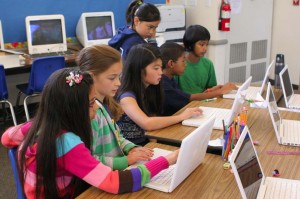I've dealt with this kind of trepidation before, when we introduced a new math curriculum that emphasized word problems and conceptual learning, which replaced the teach-drill-test approach that most adults with school-aged kids remembered. When I began to change my teaching to capitalize on the Internet and address important skills like collaborating online, I realized that I would once again need to engage parents, provide a sound rationale, and work through the fear factor.
Sometimes teachers believe parents are overly concerned about our uses of technology, but I don’t think that’s true. I’ve learned that anything new — whether it is a new curriculum, new support materials or a new kind of instructional strategy — is going to generate parent questions.
Still, when it came to the Internet, most parents didn’t use much technology in school so they don’t have a context for understanding how technology and Web-based instructional tools fit into teaching and learning. That's not too difficult to address. But many parents are extra concerned about safety and privacy -- issues that seldom come up when we're just working on paper or reading out of textbooks. Parents want assurances that their child is safe. And who can blame them?
Now my Back to School Nights include a big chunk of time devoted to explaining how we use new instructional technology, some of which is based on Web 2.0 ideas. We talk about blogs, Wikis, VoiceThread, Google Docs, Diigo and more. In addition to the parent presentation, I link to examples of how these tools have been used by other students in recent years on my website. This helps parents imagine what will happen.
I also send home a letter that gives an overview of each tool students will use, including hyperlinks to the websites and screenshots that show how we’ll be using the tool. I even invite parents to take part in some of my lesson designing. It's another way to help them see how we're using the Internet to accelerate learning. And students get a chance to show off their growing skills by with homework assignments that require them to “teach a web tool to your parent.”
At the Back to School Night, one of the biggest questions is, “How can I help my student? I don’t know how to use this Web program myself.”
Great question! Last year, I started to migrate our classroom reading program in science to an online book club (Goodreads) and parents had lots of questions. I told them about other teachers’ experiences who had used this free Web service and about how the local library had just finished their summer reading program using Goodreads. I think it reassures parents when you can show that you’ve been out there doing some action research and investigating the best ways to use the Web -- and that safety is always a top priority.
LETTING PARENTS OPT OUT
Whenever possible, I also think it’s important to allow parents to opt out their child. When parents choose this option, I typically ask them whether they’d be willing to revisit the decision in a month or so, when the experiences of other students can be taken into account. Sometimes that’s all it takes to overcome initial fears. Parents hear how it works, and they're welcome to come and observe. Most decide after a few weeks to let their student join in.
In the case of our Goodreads online book club, I suggested that anyone with concerns create a family reading account at the site where they could participate in reading student book reviews and commenting alongside their child. Parents were able to witness first-hand the process of posting, who their student encountered online, and the kinds of conversations that took place.
Parental fears spring from caring and concern. As teachers, we need to respond to those fears proactively and with respect. When we do, things usually work out. It’s not my place to unilaterally dictate anything. Philosophically, I believe it’s my place to use my teacher expertise to design the most engaging, learning-packed lessons I can and to use new innovations when they make learning sense. The back-and-forth dialog with parents only improves my understanding of what I’m doing in the classroom. It gives me the chance to see my work from another, very important perspective.
Embracing the questions – anticipating the questions – flooding the home/school communications channel with continuous information – trying to establish a two-way exchange whenever possible: these are the ways to help parents learn to trust us in our teaching role and to encourage them to learn about new tools and technologies alongside their students.


